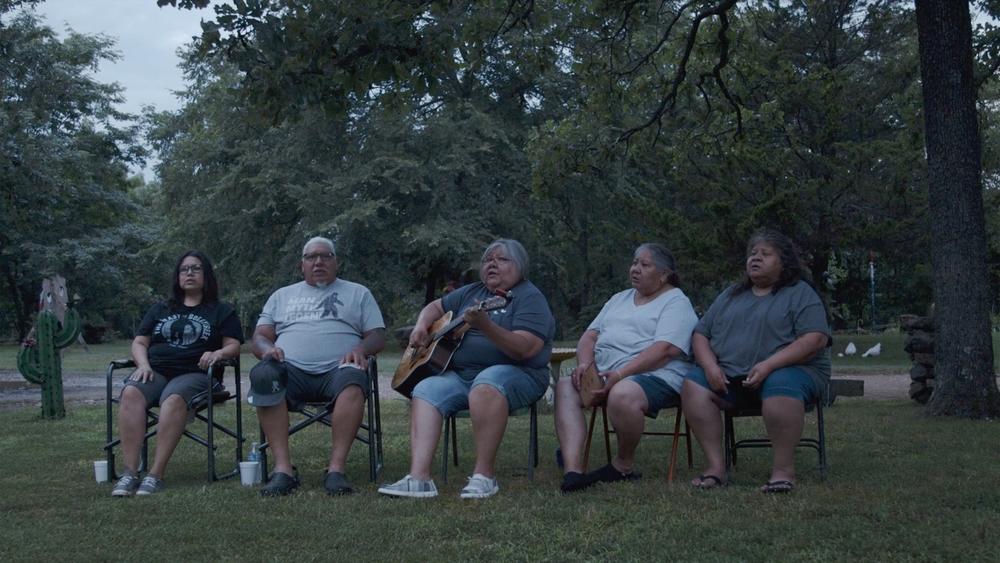
Section Branding
Header Content
‘We Will Speak’: South Arts educates audiences with inspiring Cherokee language documentary
Primary Content

On April 7, Atlanta-based regional arts organization South Arts showcased the 2023 documentary Dadiwonisi (We Will Speak) at the Plaza Theatre.
The film, which explores the role of the Cherokee language in tribal identity and cultural preservation, is part of South Arts’ 2023-24 Southern Circuit Tour of Independent Filmmakers. This annual tour connects screening partners like the Plaza with independent documentary filmmakers whose work relates to the American South. Each screening is followed by a Q&A that allows filmmakers to discuss the social themes of their work with local audiences.
The “We Will Speak” tour has featured first-time director Schon Duncan, a member of the United Keetoowah Band of Cherokee Indians and a Cherokee Language Teacher in Stilwell, Oklahoma. Producer and Cherokee visual artist Keli Gonzales, co-director Michael McDermit, and cinematographer Jacob Koestler have also attended. The tour kicked off in Clemson, South Carolina on April 1 and will now head to Roswell, Lawrenceville, and Rome, where screening partners include Berry College and the Rome International Film Festival.
Since it first launched nearly 50 years ago, South Arts’ Southern Circuit Tour has prioritized work by and for marginalized groups. The inclusion of We Will Speak demonstrates the circuit’s mission to widen audiences’ horizons on diversity, identity, and inequity in a rapidly evolving South. Shot in North Carolina and Oklahoma from 2019 to 2022, We Will Speak presents an intimate and nuanced portrait of the Cherokee People through a variety of mediums. Archival footage, interviews, and new captured footage combine to create a moving mosaic of an inspiring, persevering community.
In the film, Duncan and McDermit outline the decades of government-sponsored “Americanization” efforts that have stopped the Cherokee language from reaching younger generations; according to South Arts, under 1,600 native speakers remain today among over 430,000 Cherokee citizens. In some of the film’s most harrowing moments, elderly Cherokees reflect on their time spent in government boarding schools, sent away from their families to learn English and, in turn, slowly losing their mother tongue.
The Cherokee language, Gonzales explained, expresses feelings and sensations that English cannot quite capture; words that are abstract in English take on more concrete and meaningful definitions in Cherokee. No word is more evident of this difference than “adageyudi,” the Cherokee word for “love.” To Gonzales, this word represents a fundamental familial bond, something more intimate than its translations. “It’s emotionally deeper to me,” she said. “And [Cherokees] mean it. They wouldn’t say it to you if they didn’t mean it.”
Following Cherokee language advocates over the course of several years, We Will Speak shows the importance of this communal spirit in all of Cherokee culture. Duncan and McDermit do not structure the film around peaks of intense drama or liveliness, but rather focus on the calm and contentedness of Cherokee daily life. In small moments — a local band harmonizing on folk ballads, family members trading stories in their living room, children jumping rope at school — we glimpse the unity inherent to tribal living. These simple scenes of togetherness effortlessly exemplify the kinship that exists so largely because of and through the Cherokee language.
One of the filmmakers’ most affecting choices is letting Cherokee language learners film their stories independently of the production team, thus allowing them the chance to tell their stories through their own eyes. In one especially moving segment, Carolyn Swepston, a middle-aged mother and student in the Cherokee Language Master-Apprentice Program, takes her hand-held camera on her family’s roadtrip retracing the Trail of Tears. Driving from Oklahoma to North Carolina, Swepston records the scenery of her native homeland with the painstaking detail of an anthropologist.
Throughout the trip, Swepston often turns the camera around to film herself, capturing the intermingling enchantment and sorrow brought on by retracing her ancestors’ steps. “I don’t know why I just started crying,” she says at one point, back in the car after visiting a section of the Trail that still visibly winds through the Smokies.
It is impossible to not feel the profundity of her grief in this moment, as her Cherokee history collides with her lived Cherokee present. More than any other participant in the documentary, Swepston shows how powerful the reclamation of the Cherokee language can be for both the individual and the community. When we next see her, she has graduated from the Master-Apprentice Program and is now a teacher herself, repeating Cherokee words for plants and tools as two young students help her in the garden.
We Will Speak finds its narrative arc in Gonzales’ creation of a mural at an Oklahoma public school. In short clips over the course of the film, Gonzales sketches, outlines, then paints the mural — a Cherokee syllabary, or alphabet of the language’s syllables — with her native-speaking grandparents acting as audience members (and, it turns out, grammar editors). As we witness the expansion of Cherokee language restoration — in new schools, housing communities, and youth programs — we also watch this mural come alive with the hopes, stories, and histories of the Cherokee People. By the time we see the finished product, it is decorated with the painted handprints of Cherokees young and old; native-speakers and new learners alike.
This story comes to GPB through a reporting partnership with Rough Draft Atlanta.

